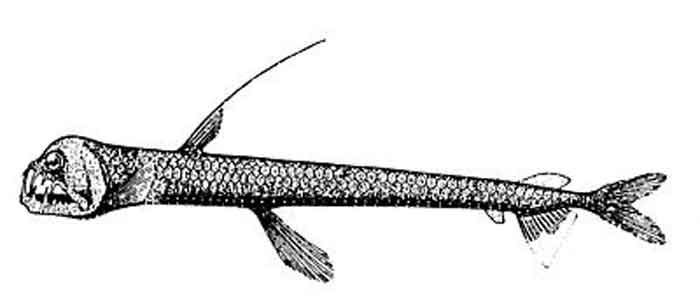Superregnum: Eukaryota
Cladus: Unikonta
Cladus: Opisthokonta
Cladus: Holozoa
Regnum: Animalia
Subregnum: Eumetazoa
Cladus: Bilateria
Cladus: Nephrozoa
Superphylum: Deuterostomia
Phylum: Chordata
Subphylum: Vertebrata
Infraphylum: Gnathostomata
Megaclassis: Osteichthyes
Superclassis/Classis: Actinopterygii
Classis/Subclassis: Actinopteri
Subclassis/Infraclassis: Neopterygii
Infraclassis: Teleostei
Superordo: Stenopterygii
Ordo: Stomiiformes
Subordo: Gonostomatoidei
Familia: Stomiidae
Subfamilia: Stomiinae
Tribus: Chauliodontini
Genus: Chauliodus
Species: C. barbatus – C. danae – C. dentatus – C. macouni – C. minimus – C. pammelas – C. schmidti – C. sloani – †C. testa – C. vasnetzovi
Name
Chauliodus Bloch & Schneider, 1801

Chauliodus danae
References
Chauliodus – Taxon details on Integrated Taxonomic Information System (ITIS).
Vernacular names
Deutsch: Viperfische
English: Viperfish
français: Poisson-vipère
한국어: 바이퍼피시
中文: 蝰魚
A viperfish is any species of marine fish in the genus Chauliodus. Viperfishes are mostly found in the mesopelagic zone and are characterized by long, needle-like teeth and hinged lower jaws. A typical viperfish grows to lengths of 30 cm (12 in). Viperfishes undergo diel vertical migration and are found all around the world in tropical and temperate oceans. Viperfishes possess photophores along the ventral side of their body, likely used to camouflage them by blending in with the less than 1% of light that reaches to below 200 meters depth.
Although it may appear to be covered in scales, viperfishes do not possess scales. Rather, they are covered by a thick, transparent coating of unknown substance.[2] Extremely large, fang-like teeth give the fish a slightly protruded lower jaw.
Habitat
Viperfishes live in meso- and bathypelagic environments where humans cannot easily make direct observations. Viperfishes engage in diel vertical migration, meaning they migrate up into more productive waters during the night to feed. [3] However, it is likely that only part of the total population of viperfishes engages in diel vertical migration in any given night, which could be due to their slow metabolism, i.e. they likely do not have to feed every night. [4]
Feeding
Viperfishes, depending on the species, prey on other pelagic fishes and crustaceans. Stomach contents of captured individuals have contained lanternfishes, bristlemouths, copepods and krill. [5]
Species
There are currently nine extant recognized species in this genus:[6]
Chauliodus barbatus Garman, 1899
Chauliodus danae Regan & Trewavas, 1929 (Dana viperfish)
Chauliodus dentatus Garman, 1899
Chauliodus macouni T. H. Bean, 1890 (pacific viperfish)
Chauliodus minimus Parin & Novikova, 1974
Chauliodus pammelas Alcock, 1892
Chauliodus schmidti Ege, 1948
Chauliodus sloani Bloch & J. G. Schneider, 1801 (Sloane's viperfish)
Chauliodus vasnetzovi Novikova, 1972
At least two more species are recognized from Late Miocene-aged fossils:
Chauliodus eximus, (Jordan, 1925), originally Eostomias eximus, from Late Miocene California
Chauliodus testa, Nazarkin, 2014, from the Late Miocene of Western Sakhalin Island[7]
See also
Bathypelagic fish
Deep-sea fish
Mesopelagic zone
References
Sepkoski, J. John Jr. (2002-09-16). Jablonski, David; Foote, Michael (eds.). "A compendium of fossil marine animal genera". Bulletins of American Paleontology (363): 5–560. ISBN 0877104506. ISSN 0007-5779. LCCN 2002108976. Retrieved 2018-02-15.
Haffner, Rudolph E. (1952-09-01). "Zoogeography of the bathypelagic fish, Chauliodus". Systematic Zoology. 1 (3): 113–133. doi:10.1093/sysbio/1.3.113. ISSN 1063-5157.
Sutton, T. T.; Hopkins, T. L. (1996). "Trophic ecology of the stomiid (Pisces: Stomiidae) fish assemblage of the eastern Gulf of Mexico: Strategies, selectivity and impact of a top mesopelagic predator group". Marine Biology. 127 (2): 179–192. doi:10.1007/BF00942102. S2CID 85197451.
Eduardo, Leandro Nolé; Lucena-Frédou, Flávia; Mincarone, Michael Maia; Soares, Andrey; Le Loc'h, François; Frédou, Thierry; Ménard, Frédéric; Bertrand, Arnaud (2020). "Trophic ecology, habitat, and migratory behaviour of the viperfish Chauliodus sloani reveal a key mesopelagic player". Scientific Reports. 10 (1): 20996. doi:10.1038/s41598-020-77222-8. PMC 7710699. PMID 33268805.
Battaglia, P.; Ammendolia, G.; Esposito, V.; Romeo, T.; Andaloro, F. (2018). "Few but Relatively Large Prey: Trophic Ecology of Chauliodus sloani (Pisces: Stomiidae) in Deep Waters of the Central Mediterranean Sea". Journal of Ichthyology. 58: 8–16. doi:10.1134/S0032945218010034. S2CID 3804319.
Froese, Rainer and Pauly, Daniel, eds. (2012). Species of Chauliodus in FishBase. February 2012 version.
M. V. Nazarkin (May 2014). "The fossil viperfish Chauliodus testa sp. nov. (Stomiiformes: Stomiidae) from the Neogene of western Sakhalin, Russia". Paleontological Journal. 48 (3): 317–325. doi:10.1134/S0031030114030150. S2CID 132146745.
Retrieved from "http://en.wikipedia.org/"
All text is available under the terms of the GNU Free Documentation License

